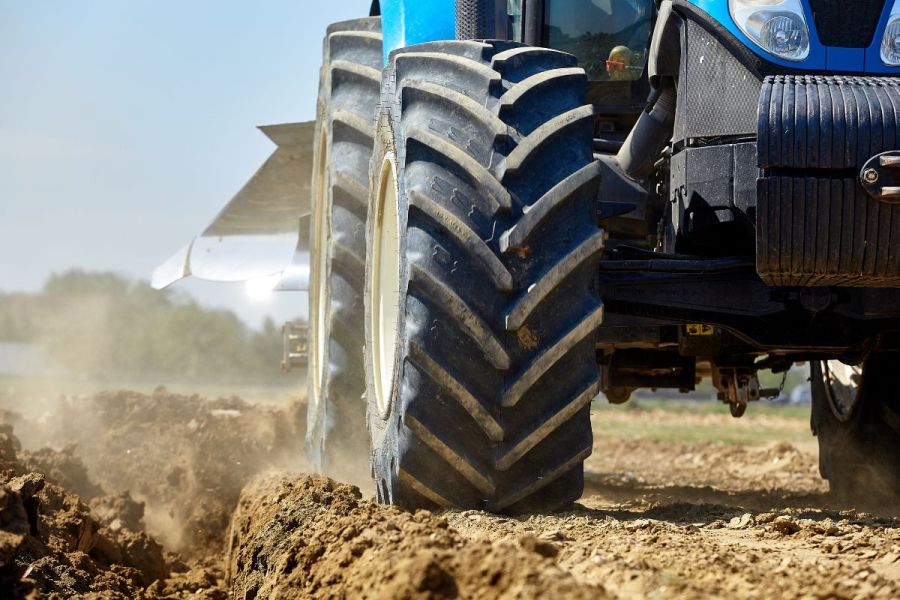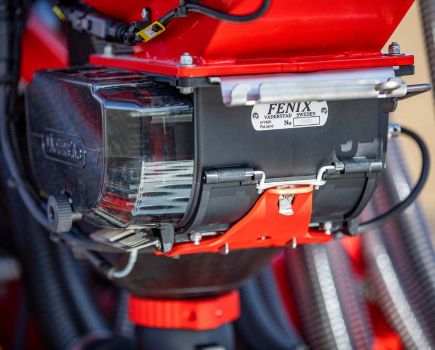Protecting and preserving soil health has never been more important, and using the right tyre at the correct pressure can play a big role in this. CPM takes a look at how advancing tyre technology can lead to healthier soils.
“The heavier tractor with better tyres can work at lower pressure which will be better for the soil.”
By Melanie Jenkins
Tyres are more than just a practical aspect of operating a tractor, and as tyre technology advances, their functionality brings an increasing number of benefits to the field and machine operation, not the least of which is minimising soil compaction.
The necessity to make soils more resilient is becoming increasingly important, says soil specialist Philip Wright of Wright Resolutions. “There are many ways of doing this, but they’re all about optimising soil structure to enable free pathways for the roots, air and water to pass through it.
“Soils have to be aerobic for roots to interact with the biology and to allow efficient plant growth. But to achieve this there has to be good drainage and a balance of air and water in the soil pores. In an ideal situation there’d be about a 50/50 split of porosity to solid fraction.”
But unavoidably, when machinery is driven across soils it causes ground compaction by squeezing soils together, reducing the porosity and ability for soils to store air and water, he explains. “To reduce this, we have to minimise the amount of pressure applied to the ground, which means using very flexible tyres capable of supporting weight at such low pressures.”
Over the past four years Philip has measured the impact of tyre pressure on cereal yields on two different regen farms, with varying soil types. “One farm uses a Weaving direct drill and the other a Horizon single undercut disc direct drill – neither with eradicators.”
Tyre pressures were set at three different levels: 1bar, 0.8bar and 0.6bar. “The yield of each un-trafficked area was compared with that of the drill tractor wheel lines to determine the impact pressure had on this,” he explains. “If the un-trafficked area yield amounted to 100%, then 1bar of pressure produced yields at around 60%, which is quite worrying. In a scenario with 710 tyres, the two tyres will have a width of 1.5m, and if you’re using a 3m drill, this could potentially be creating a yield loss of 40% across half your farm.”
But by reducing the tyre pressure to 0.8bar, the yield average went up to 70%. Reducing the pressure further to 0.6bar saw yields achieve just over 90%. “Evidently, the less pressure applied, the more the soil maintains porosity and structure, helping drainage, crops and yields. Another big factor is that better crops are more competitive, helping to reduce instances of weeds such as blackgrass in the wheel lines.”
But only reduce tyre pressure if it’s safe to do so, warns Philip. “If you go below the safe minimum level the tyre can collapse and fail, which is expensive. I’d advise involving your manufacturer as most will come to your farm if you operate their tyres, bringing a weigh cell to check axle loads, configuration and ballasting to determine a safe minimum pressure to help you avoid instances of underinflation.”
Another consideration related to tyre pressure is fuel efficiency. “A highly inflated tyre will increase fuel consumption because tyres slip more in this situation, meaning each rotation requires more power from the tractor.”
Other than optimising tyre pressures, there’s also the option of implementing controlled traffic farming to limit the areas of the field impacted, but turning in headlands can still be problematic. “We’re still going to have to drive somewhere in the field, so it’s still important to minimise the impact in these areas,” says Philip.
And there’s always the issue that road speeds are much faster than field speeds, requiring higher pressure in the tyres. “This is where central tyre inflation systems go hand-in-hand with protecting soils. These can be implemented upon entry or exit to a field without the driver having to exit the cab to use an airline, which they’re unlikely to be willing to do multiple times a day.”
Philip also warns about oversizing the tyre system for a tractor. “If a tyre with too much volume is fitted to a lighter tractor, there won’t be enough weight to push and flex the tyre properly, meaning there ends up being a smaller than optimal contact area.”
But when faced with difficult field conditions, he would always advocate a slightly heavier tractor with high-tech tyre rather than a lighter tractor with high pressure radials. “The heavier tractor with better tyres can work at lower pressure which will be better for the soil.”
One of the key drivers in tyre development has been the increased interest and pressures related to soil health and protection, explains Denis Piccolo of BKT. “Due to the changes of agriculture’s approach to this, we’ve felt a necessity to introduce a tyre that’s able to reduce the contact pressure on the soil.”
BKT’s solution has been the Agrimax V-Flecto, which is suited for use with high horsepower tractors and has been specifically designed for soil tillage and haulage applications ensuring a reduced soil compaction and self-cleaning properties. “We aimed to meet the growing requirement for technology and higher performance on these types of machines.
This tyre is designed to deliver both performance and reliability, proving high resistance against greater stress levels as well as faster speeds, even on paved roads.”
The Very High Flexion tyre technology (VF) reduces the contact pressure and can help increase profitability of harvesters, says Denis. “If the standard tyre at 1.6bar can safely support a given weight, then the Improved Flexion (IF) and VF will support 20% and 40% more, respectively. Alternatively, these IF and VF tyres could run at 20% or 40% reduced pressures for the same weight.”
According to Denis, the market trend has become more and more focused on VF tyres. “These assure the maximum soil protection thanks to their technical characteristics. In the past few decades there’s been progressive compaction of farming soils: the losses attributed to this are estimated to amount to about 20% of the total harvest. Limiting soil compaction is an urgent practice we have to work on to help maximise the yield per hectare.”
To target this, Denis explains that the Agrimax V-Flecto shows an optimised footprint and a 10% larger tread profile compared with a standard tyre of the same size. “This leads to a notable decrease in soil compaction, resulting in major overall efficiency in terms of both farming operations and business profits, helping to assure good yields in the following season.”
The Agrimax V-Flecto has been developed for the purpose of meeting the requirement of maximising load capacity. “Ordinary VF tyres carry 40% heavier loads compared with a standard tyre of the same size and same inflation pressure. However, the VF tire normally requires a wider rim. In order to provide users the opportunity to fit VF technology tyres without changing the original rim, the narrow rim option (NRO) tyre was introduced. A NRO marked VF tyre is also able to sustain 40% more weight compared with a standard tyre of the same size with same inflation pressure and on the same rim.”
This tyre also differentiates from standard tyres because it has a long product life cycle giving a more optimised return on investments, says Denis. “Compared with an equivalent standard tyre, it ensures longer life, resulting in less overall operating costs without compromising performance, strength and long wear over the time.”
The Agrimax V-Flecto should provide comfortable driving conditions, he explains. “This is becoming a more and more essential element for today’s farmers. That’s why it has been designed with optimised geometrical features, aimed at reducing operator’s fatigue, vibrations and lower noise levels in the cabin.”
The VF technology has also been introduced on trailer flotation tyres (V-Flexa) to grant the maximum soil protection during the harvesting season, says Denis. “The V-Flexa is a tyre specifically designed for agricultural trailers and is steel belted to increase the tyre resistance against impacts and punctures.
“BKT developed the VF tyres by looking closely at the impact of tyres on soil using phenolic sponges. This system gives us the possibility to easily study and through a 3D model, and precisely measure the impact of the tyres on soil compaction.”
Besides reduced soil compaction, there are also applications where the most important job for the tyres is the load capacity, he explains. “Here the role of the tyre becomes fundamental. In these instances, using a narrow size row crop tyre like the Agrimax Spargo, fitted on self-propelled or high clearance sprayers can be very beneficial. This tyre is specifically designed for row crop application; the strong casing and an increased number of lugs ensure better stability both in field and on the road.”
The development of the VF tyres required the introduction of new technologies and materials, which carried its own challenges, says Denis. “The most critical difficulty to overcome was the overheating of the sidewall and the construction of the bead. The sidewall is continuously subjected to elongation and compression that can cause overheating, consequently resulting in cracking and separation on the sidewall area. This difficulty was solved by introducing polyester cords and special compounds for the casing plies.
“In addition, the special polyester casing enables the tyre to rapidly regain its correct shape even after longer standstills,” he explains.
The bead shape and material used have also been assessed to assure good clamping on the rim at low pressures. “This is something that is required during soil preparation, or when there are heavy loads. It’s also useful when there are lateral forces acting on the tyres during road rolling with the narrow Row Crop tyres.”
Tyre choice will therefore come down to the task being undertaken, says Denis. “The larger VF tyres are best for soil preparation, but for spreading activities the narrow tyres are more suitable as they help to reduce root damage.”
This article was taken from the latest issue of CPM. Read the article in full here.
For more articles like this, subscribe here.
Sign up for Crop Production Magazine’s FREE e-newsletter here.




